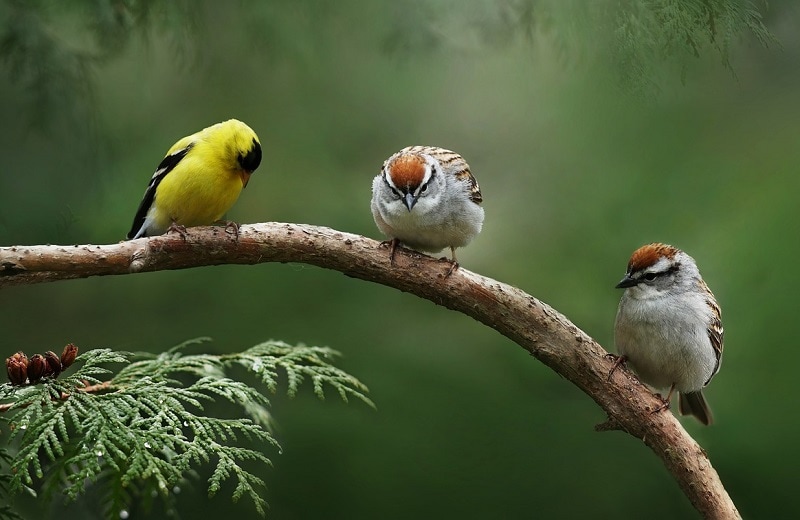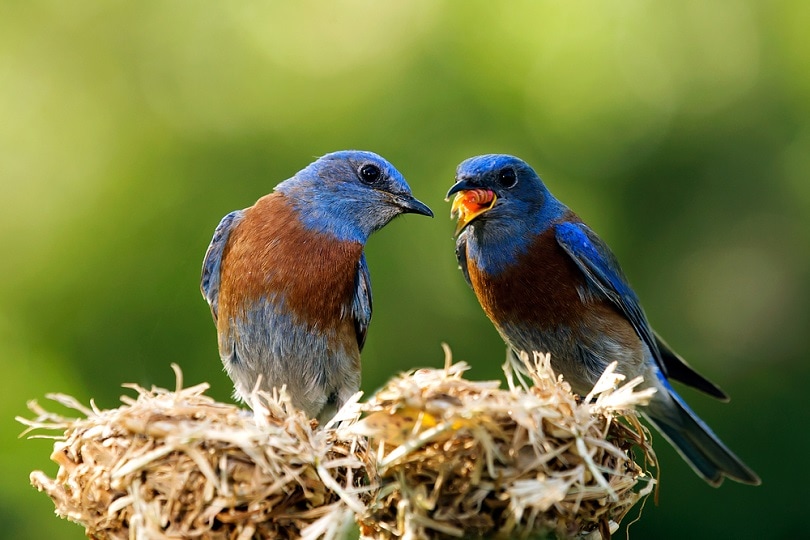12 Proven Ways to Attract More Birds to Your Yard
Last Updated on

Birds are not unlike other wildlife species. They strive to meet their basic needs for food, water, and shelter to survive. Doing so efficiently with minimal energy expenditure underscores many of the adaptations that have occurred during their collective evolution. After all, the goal of all organisms is to live long enough to reproduce and pass on their DNA.
That’s where you need to begin when looking for ways to attract more birds to your yard. When you study them, it’s to see how well-adapted they are to face environmental challenges. This fact provides additional clues that can help you succeed in your quest to lure more to your yard.
A few modifications and additions to your landscaping can make a profound impact on the desirability of your property from an avian perspective. Bear in mind that inviting birds to your yard can have far-reaching impacts that you should take into account too.

Before You Start
Many bird species are specialized animals, whether it’s their habitat, food sources, or foraging methods. That means you should consider what species you want to attract first. After all, there are about 18,000 species in the world. The changes that you make to encourage Northern Cardinals differ from what you would do to open the door to Ruby-Throated Hummingbirds.
You should also think about the types of changes that you’re willing to make. Sometimes, merely putting out a preferred food source is enough to get avian visitors to your yard. Other times, birds have additional needs. For example, Upland Sandpipers need large blocks of uninterrupted habitat to meet their requirements.

The fact remains that many songbirds are also prey species. If you put out the welcome mat for them, you’re also opening the door for predators, such as falcons and hawks. Then, there are opportunistic mammals that may follow the gravy train. Remember that a bird feeder is likely to attract many unwelcome guests, such as bears, raccoons, and rodents.
Covering the Bases
Attracting birds involves a commitment. These animals will rely on the food and other things that you provide. It’s not as much an issue during the warmer months of the year when they can find alternatives. It’s another matter entirely if you don’t fill the feeder during the winter when birds have few places to turn to for food sources.
Our advice is to take this responsibility seriously. Think about what you’re willing to do and whether it’s something that you can make a long-term commitment toward fulfilling. Remember that it involves time and effort for things like filling a birdbath. It also means dishing out cash. People who feed birds spend $60 a year on average.
We also have to address the elephant in the room: cats. Experts estimate that felines kill about 2.4 billion birds a year. That’s one reason that Eastern Bluebird houses have a slanted roof, to deter predators.
Research the Needs of the Species That You Want to Attract
The life history of a bird species is a blueprint for attracting them to your yard. That’s where you must begin. They have preferences for food types, plants, and shelter types. Generalist species that will take whatever they can find. Others seek out specific foodstuffs.
The next thing you need to do is to determine if you can fulfill those needs. If you have wetlands on your property, you’re halfway there toward attracting waterfowl and wading birds. Likewise, a wooded yard can provide an ideal setting for forest-dwelling species.
Then, determine how much time-money-effort that you want to commit. We suggest working with what you have instead of trying to create something unsuitable for your land and climate. It’s easier to work with a shrubland habitat than trying to make a wetland where the land does not support it. However, there are alternatives. You can install a pond, but it will come at a cost in terms of time and money.

1. Explore Your Shelter Options
Shelter is the best way to start. Birds will visit different spots for a meal. If you want them to take up residence in your yard, you have to fulfill their needs. Sometimes, it’s just as simple as planting shrubbery that will provide cover and potential nesting spots. Other times, it’s a full-blown restoration. Bear in mind that it often takes time to establish different habitats.
2. Upgrade Your Landscaping With Native Plants
Since they are often prey species, many birds are wary of new things in their environment, especially if their contact with humans is limited. Landscaping with native plants provides food that your avian visitors may prefer. It’s also beneficial for you because it’ll mean less maintenance and better success with suitable plants for your area.
3. Put Out Favorite Foods
Many birds have their favorite foods. For example, Baltimore Orioles have a sweet tooth for fruits. Putting out treats like oranges is sure to attract visitors to your yard, both wanted and unwanted. You can put half on a branch, which will help the birds feel protected as they feast on the orange. Likewise, many species enjoy sunflower seeds, such as Chickadees. A few well-placed plants will attract them.
4. Invest in a Feeder
Hanging a bird feeder is an excellent way to invite birds to your yard that doesn’t take much effort. We recommend following the 5-7-9 rule for placing it out of the reach of squirrels. That means putting a free-standing feeder at least 5 feet high, 7 feet from any launching platform, like a tree, and 9 feet from overhanging branches.

5. Offer High-Quality Food Sources
It’s essential to offer high-quality food sources that you can purchase from a reputable retailer with a high turnover rate. Birds often avoid stale food, sticking with food that will provide optimal energy and nutrition. Unfortunately, bargain wild bird food brands sometimes contain seeds that few birds like, such as milo, wheat, and safflower seeds. If you see many discarded ones, avoid those seed types.
6. Provide a Water Source
Seed-eating birds need a water source to supplement their diet. You can set up a birdbath, which will also give them something to splash around and get clean in. Another option is to set up a pond in your backyard. While it’s more work, it will likely attract a wide variety of species. It’s also a delightful addition to any landscaping project.
7. Install a Birdhouse
Some birds are cavity-nesting, such as Eastern Bluebirds and Black-Capped Chickadees. Providing a birdhouse with the correct size hole will often sway your avian friends to stay. The opening size is vital because it can deter non-targeted species if they can’t get inside the box. The correct height is also essential. For example, Nuthatches prefer it as least 5 feet off the ground, whereas Purple Martins like 10 feet better.
8. Encourage Birds to Nest in Your Yard
Some species don’t use cavities or houses. Instead, they make their own. Red-Winged Blackbirds often build their nests in small trees and bushes near water. On the other hand, Grasshopper Sparrows make a place in dense grasses. Providing suitable plants and nesting material will make the choice easy for these birds.

9. Take Care of the Birds’ Winter Needs
Year-round residents will appreciate high-energy food sources, such as suet. These nutrient-dense treats will help the birds stay warm and ensure that they are getting enough to eat when their regular foodstuffs are scarce. You should use a wire basket product that will help prevent squirrels and other rodents from stealing the treat.
10. Keep It Clean
It’s imperative to keep feeders, birdbaths, and nesting boxes clean. This will help prevent diseases that could wipe out a population. It’s also a deterrent to the birds that you want to attract. Don’t forget to clean the area underneath any feeders, as that can attract mice and other nuisance wildlife. We suggest leaving the birdhouses up through the winter to provide suitable roosting spots.
11. Deter Non-targeted Species
The question isn’t if you’ll have interlopers, it’s when it will happen. To ensure that you can provide a reliable food source, make it more difficult for other animals to steal it from the birds. A squirrel baffle is a must-have to keep these pests at bay. It will prevent them from getting to the feeder, and hopefully, they’ll move on to someplace else.
12. Reduce Conflicts
Conflict is inevitable, whether it’s interlopers like Cowbirds or deer raiding your bird feeders at night. We recommend monitoring your setup to stop problems in their tracks. For example, moving the location of your hummingbird feeder can deter bees. We also suggest that you limit activity near any items that you’ve put out for the birds to avoid harassing them.


Conclusion
Inviting birds into your yard is an excellent way to bring nature closer to home. It offers opportunities for teaching moments with your kids. It’s also a way to give back to the planet that many individuals find rewarding. While we can’t remove all the threats that birds face, we can offer them a safe place with the food, water, and shelter that they desperately need for survival.
Featured Image Credit: MiniMe-70, Pixabay
Table of Contents
- Before You Start
- Covering the Bases
- Research the Needs of the Species That You Want to Attract
- 1. Explore Your Shelter Options
- 2. Upgrade Your Landscaping With Native Plants
- 3. Put Out Favorite Foods
- 4. Invest in a Feeder
- 5. Offer High-Quality Food Sources
- 6. Provide a Water Source
- 7. Install a Birdhouse
- 8. Encourage Birds to Nest in Your Yard
- 9. Take Care of the Birds’ Winter Needs
- 10. Keep It Clean
- 11. Deter Non-targeted Species
- 12. Reduce Conflicts
- Conclusion
About the Author Robert Sparks
Robert’s obsession with all things optical started early in life, when his optician father would bring home prototypes for Robert to play with. Nowadays, Robert is dedicated to helping others find the right optics for their needs. His hobbies include astronomy, astrophysics, and model building. Originally from Newark, NJ, he resides in Santa Fe, New Mexico, where the nighttime skies are filled with glittering stars.
Related Articles:
10 Types of Hummingbirds in Arkansas (With Pictures)
8 Types of Hummingbirds in Nebraska (With Pictures)
5 Types of Hummingbirds in Idaho (With Pictures)
3 Types of Hummingbirds in Mississippi (With Pictures)
8 Types of Hummingbirds in Kansas (With Pictures)
5 Types of Hummingbirds in West Virginia (With Pictures)
5 Types of Hummingbirds in Ohio (With Pictures)
Where Do Nuthatches Nest? Nuthatch Nesting Habits Explained
